

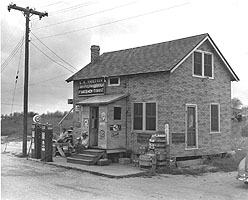 85.
1949: Mary and I found this scene on Deale Island on our first exploratory
trip to the Eastern Shore. We were just discovering Maryland; the Bay Bridge
hadn't been built yet, so the Shore seemed very different and isolated.
I had begun taking a few pictures for the Department of Information, but
they certainly wouldn't have wanted a scene like this. I took it for myself--how
could you resist taking a picture like this? MSA SC 1890-20-12,334-01
85.
1949: Mary and I found this scene on Deale Island on our first exploratory
trip to the Eastern Shore. We were just discovering Maryland; the Bay Bridge
hadn't been built yet, so the Shore seemed very different and isolated.
I had begun taking a few pictures for the Department of Information, but
they certainly wouldn't have wanted a scene like this. I took it for myself--how
could you resist taking a picture like this? MSA SC 1890-20-12,334-01
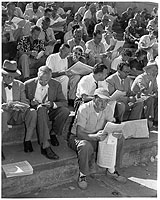 86.
1952: Peripheral vision is a great advantage for a photographer. Out of
the corner of my eye, I saw this scene just after shooting the finish of
a horse race at Timonium. I've always loved this picture because the faces
reveal so clearly the dejected feelings of the obvious losers contrasted
with those hoping for better luck in the next race. It's a real study of
human nature. MSA SC 1890-04-1437
86.
1952: Peripheral vision is a great advantage for a photographer. Out of
the corner of my eye, I saw this scene just after shooting the finish of
a horse race at Timonium. I've always loved this picture because the faces
reveal so clearly the dejected feelings of the obvious losers contrasted
with those hoping for better luck in the next race. It's a real study of
human nature. MSA SC 1890-04-1437
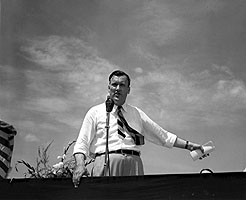 87.
June 25, 1952: I took hundreds of photographs of Governor McKeldin: I was
his unofficial official photographer. Back in those days there was no budget
for a photographer, so he paid me out of his own pocket. He liked having
his picture taken and wanted to have a thorough record of his administration.
This was made at the dedication of Sandy Point State Park. I think it summarizes
McKeldin as the great patriotic orator he was--I just wish I'd included
more of the flag. MSA SC 1890-43-12,433-06
87.
June 25, 1952: I took hundreds of photographs of Governor McKeldin: I was
his unofficial official photographer. Back in those days there was no budget
for a photographer, so he paid me out of his own pocket. He liked having
his picture taken and wanted to have a thorough record of his administration.
This was made at the dedication of Sandy Point State Park. I think it summarizes
McKeldin as the great patriotic orator he was--I just wish I'd included
more of the flag. MSA SC 1890-43-12,433-06
 88.
1952: This was a commercial assignment for an insurance company. They hired
me to go down to Harwood to photograph the scene of an accident on a sharp
curve on Route 2. That's why I included so much foreground, so you could
see the skid-marks. The picture was probably used as evidence in a court
case. I filed the negative away even though it was soon obsolete in terms
of the original assignment. I kept all my negatives no matter what the
subject was. Now a picture like this takes on a whole new meaning as an
historical record of a time long gone and a place considerably changed.
MSA SC 1890-02-10,142A
88.
1952: This was a commercial assignment for an insurance company. They hired
me to go down to Harwood to photograph the scene of an accident on a sharp
curve on Route 2. That's why I included so much foreground, so you could
see the skid-marks. The picture was probably used as evidence in a court
case. I filed the negative away even though it was soon obsolete in terms
of the original assignment. I kept all my negatives no matter what the
subject was. Now a picture like this takes on a whole new meaning as an
historical record of a time long gone and a place considerably changed.
MSA SC 1890-02-10,142A
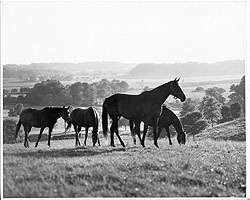 89.
1955 circa: This photograph was taken at the end of a typical day out with
the family, touring the state and taking pictures. We'd been to Havre de
Grace and Union Mills, and wound up here at Sagamore Farms in Baltimore
County. This was the only really good photograph I took all day. The lighting,
mood, and placement of the horses were all just right. I could go back
twenty times and it would never be the same. MSA SC 1890-04-1080
89.
1955 circa: This photograph was taken at the end of a typical day out with
the family, touring the state and taking pictures. We'd been to Havre de
Grace and Union Mills, and wound up here at Sagamore Farms in Baltimore
County. This was the only really good photograph I took all day. The lighting,
mood, and placement of the horses were all just right. I could go back
twenty times and it would never be the same. MSA SC 1890-04-1080
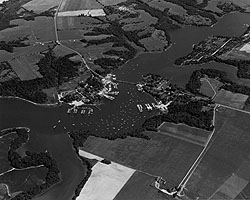 90.
September 9, 1958: I think this shot really symbolizes the Eastern Shore
landscape. I like the way it shows the lay of the land with the Sassafras
River snaking through it in such an interesting pattern. Dave Scott, my
pilot, was a sailor; he was the one who first noticed this view of Georgetown.
I'm sure it was the sailboats that caught his eye. He loved photography
as much as I do, and was always helping me find a good subject. MSA SC
1890-15-1741
90.
September 9, 1958: I think this shot really symbolizes the Eastern Shore
landscape. I like the way it shows the lay of the land with the Sassafras
River snaking through it in such an interesting pattern. Dave Scott, my
pilot, was a sailor; he was the one who first noticed this view of Georgetown.
I'm sure it was the sailboats that caught his eye. He loved photography
as much as I do, and was always helping me find a good subject. MSA SC
1890-15-1741
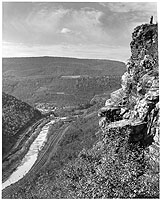 91.
October 1958: I've always told my wife that this is my favorite portrait
of her. It was taken at Cumberland Narrows. To set up this shot, we were
able to drive only part of the way up the mountain, up a road to a deserted
nightclub. From there we had to carry all of the equipment up the hill.
Then Mary continued to climb out to the promontory called Lover's Leap.
I told her I wanted an action shot, but she wouldn't go along with it.
MSA SC 1890-01-1195
91.
October 1958: I've always told my wife that this is my favorite portrait
of her. It was taken at Cumberland Narrows. To set up this shot, we were
able to drive only part of the way up the mountain, up a road to a deserted
nightclub. From there we had to carry all of the equipment up the hill.
Then Mary continued to climb out to the promontory called Lover's Leap.
I told her I wanted an action shot, but she wouldn't go along with it.
MSA SC 1890-01-1195
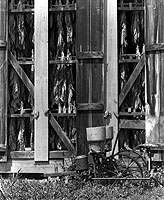 92.
1968: I rarely get more than two or three good pictures in a day, and sometimes
only one. I was driving in Calvert County, on my way to photograph a cypress
swamp (93), when I saw this tobacco barn. The lighting was perfect, and
I quickly set up the camera. I debated about removing the Nehi bottle,
but decided that it added the human element. I almost shot it both ways--with
the bottle and without it--but I said, no sir, you don't chicken out, you
shoot it the way you see it. MSA SC 1890-05-2500
92.
1968: I rarely get more than two or three good pictures in a day, and sometimes
only one. I was driving in Calvert County, on my way to photograph a cypress
swamp (93), when I saw this tobacco barn. The lighting was perfect, and
I quickly set up the camera. I debated about removing the Nehi bottle,
but decided that it added the human element. I almost shot it both ways--with
the bottle and without it--but I said, no sir, you don't chicken out, you
shoot it the way you see it. MSA SC 1890-05-2500
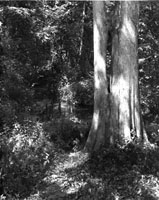 93.
1968: This scene was taken at the Battle Creek Cypress Swamp long before
they built the boardwalk that's there now. I'll never forget taking this
picture, nor the price I paid for it. After I decided that this was the
view I wanted, I had to clean it up a bit to bring out the texture of the
tree. Even though it's a natural photograph, sometimes you have to doctor
things up to highlight the points of interest. In this case, there was
a huge vine hanging from the big tree, so I got out my machete and pulled
it down. Needless to say, I got poison ivy all the way up to my elbows.
MSA SC 1890-05-2521A
93.
1968: This scene was taken at the Battle Creek Cypress Swamp long before
they built the boardwalk that's there now. I'll never forget taking this
picture, nor the price I paid for it. After I decided that this was the
view I wanted, I had to clean it up a bit to bring out the texture of the
tree. Even though it's a natural photograph, sometimes you have to doctor
things up to highlight the points of interest. In this case, there was
a huge vine hanging from the big tree, so I got out my machete and pulled
it down. Needless to say, I got poison ivy all the way up to my elbows.
MSA SC 1890-05-2521A
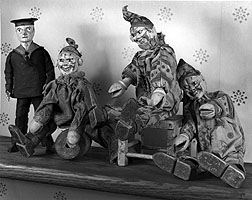 94.
April 2, 1968: American History Illustrated hired me to do a story
on Union Mills Homestead in Carroll County. They wanted pictures of all
the rooms, about twenty shots. It takes up to an hour to set up for each
one, so I was there for two full days. After a while it started to get
deadly just shooting one room after another, so I decided to do something
fun to add some variety. I went around the house and gathered up these
dolls, then set them on a shelf and played with them until I got a composition
I liked. The picture added humor and a human-like touch to what was otherwise
a pretty lifeless story. MSA SC 1890-07-2396-18
94.
April 2, 1968: American History Illustrated hired me to do a story
on Union Mills Homestead in Carroll County. They wanted pictures of all
the rooms, about twenty shots. It takes up to an hour to set up for each
one, so I was there for two full days. After a while it started to get
deadly just shooting one room after another, so I decided to do something
fun to add some variety. I went around the house and gathered up these
dolls, then set them on a shelf and played with them until I got a composition
I liked. The picture added humor and a human-like touch to what was otherwise
a pretty lifeless story. MSA SC 1890-07-2396-18
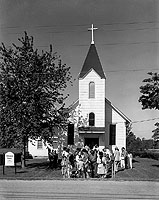 95.
May 11, 1986: For several years I was preoccupied with commercial and industrial
assignments, so I didn't have the time to document the state the way I
once had. It wasn't until I started The Bay Project that I really started
saturation shooting again, recording every aspect of life on and near the
Chesapeake. St. Elizabeth's Church is in Westover, near my daughter's home
in Somerset County. We go to church there sometimes; this Sunday, I set
up the camera across the street before Mass, then went inside for the service.
When it was over, I ran out and got to the camera as the people were coming
out. No one even noticed I was taking the picture. MSA SC 1890-20-6974-1
95.
May 11, 1986: For several years I was preoccupied with commercial and industrial
assignments, so I didn't have the time to document the state the way I
once had. It wasn't until I started The Bay Project that I really started
saturation shooting again, recording every aspect of life on and near the
Chesapeake. St. Elizabeth's Church is in Westover, near my daughter's home
in Somerset County. We go to church there sometimes; this Sunday, I set
up the camera across the street before Mass, then went inside for the service.
When it was over, I ran out and got to the camera as the people were coming
out. No one even noticed I was taking the picture. MSA SC 1890-20-6974-1
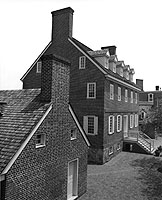 96.
1988: I was very excited when I found this new angle to shoot the Paca
House in Annapolis. I'd been working for several years making illustrations
for a new book called The Great Houses of Maryland, but I hadn't
come up with something I thought was right for the cover and I was running
out of time. I wanted a picture that would be representative of all the
great houses without being instantly identifiable. After I took this, I
knew I had what I wanted, but I sent it to the publisher without comment.
He called up right away and said he wanted to use it on the cover. MSA
SC 1890-02-11,000A
96.
1988: I was very excited when I found this new angle to shoot the Paca
House in Annapolis. I'd been working for several years making illustrations
for a new book called The Great Houses of Maryland, but I hadn't
come up with something I thought was right for the cover and I was running
out of time. I wanted a picture that would be representative of all the
great houses without being instantly identifiable. After I took this, I
knew I had what I wanted, but I sent it to the publisher without comment.
He called up right away and said he wanted to use it on the cover. MSA
SC 1890-02-11,000A
| The Eye of the Beholder | The War and Before |
| Sleepytime Annapolis | Annapolis in Blossom |
| The Chesapeake Bay | Vintage Photographs |
| Cityscape | About Maryland |
|
Tell Us What You Think About the Maryland State Archives Website!
|